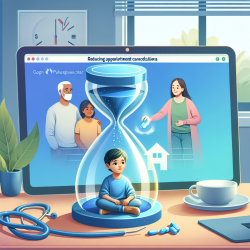Introduction
In the dynamic field of speech language pathology, the ability to adapt and implement evidence-based practices (EBPs) effectively is crucial for achieving the best outcomes for children. A recent study, "Incorporators, Early Investors, and Learners: A Longitudinal Study of Organizational Adaptation during EBP Implementation and Sustainment," sheds light on how organizations can successfully adapt during the implementation of EBPs. This blog will explore the key findings of the study and provide insights for practitioners looking to enhance their skills and improve outcomes for children.
Understanding Organizational Adaptation Profiles
The study identifies three distinct organizational adaptation profiles: Incorporators, Early Investors, and Learners. Each profile represents a different approach to integrating EBPs within an organization, highlighting the diverse paths to achieving sustainment.
- Incorporators: These organizations integrate EBPs into existing structures with minimal changes. They focus on assimilating the new practices into their current operations, making small-scale adaptations to meet contractual and fidelity requirements.
- Early Investors: These organizations make substantial adaptations during the initial implementation phases. They play a critical role in system-wide implementation, often acting as lead agencies responsible for training, coaching, and data management.
- Learners: Characterized by continuous improvement, Learners maintain a steady focus on finding new ways to support EBPs. They foster a culture of curiosity and openness, constantly seeking to enhance their practices.
Practical Implications for Practitioners
Understanding these adaptation profiles can guide practitioners in tailoring their implementation strategies to fit their organizational context. Here are some practical steps practitioners can take:
- Assess Your Organization: Identify which adaptation profile aligns with your organization. This understanding can help tailor strategies to your specific needs and resources.
- Leverage Strengths: Use the strengths of your adaptation profile to enhance implementation. For example, Incorporators can focus on optimizing existing resources, while Learners can foster a culture of continuous improvement.
- Collaborate and Learn: Engage with other organizations to share experiences and strategies. This collaboration can provide new insights and foster a supportive network for implementing EBPs.
Encouraging Further Research
While the study provides valuable insights, it also highlights the need for further research into organizational adaptation. Practitioners are encouraged to explore how different adaptation strategies can be applied in various contexts and with different EBPs. By contributing to this body of research, practitioners can help refine and expand our understanding of effective implementation strategies.
Conclusion
Organizational adaptation is a dynamic and context-driven process that plays a crucial role in the successful implementation of EBPs. By understanding and leveraging adaptation profiles, practitioners can enhance their skills and create better outcomes for children. To delve deeper into the original research, please follow this link: Incorporators, Early Investors, and Learners: a longitudinal study of organizational adaptation during EBP implementation and sustainment.










